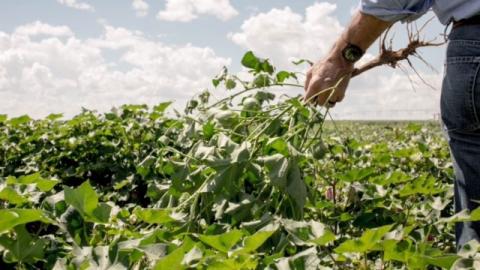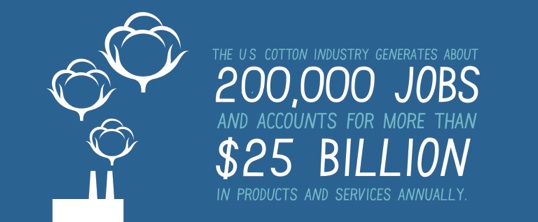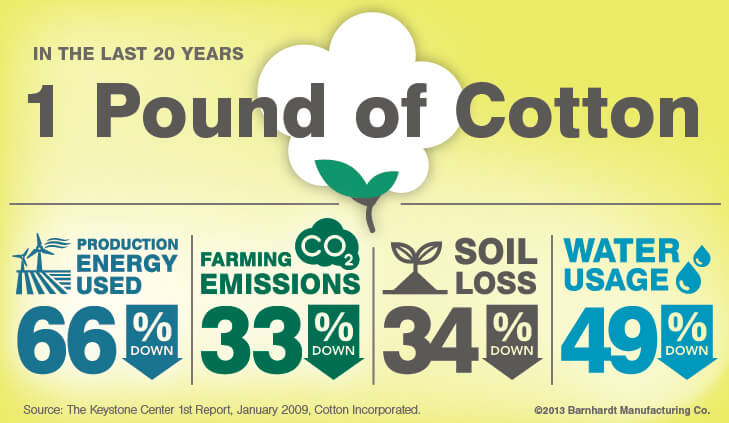Commodity Crops: Cotton
The GMO Answers’ Commodity Crop Series introduces a new crop each week to help you better understand the role these crops play in agricultural production and the U.S. economy. Over the last two weeks we explored the many uses and history of two commodity crops: soybeans and corn.
This week: Cotton - an extremely versatile crop that has been grown for thousands of years. Many of us know and recognize cotton, from our favorite t-shirt to the sheets on our bed. We use cotton every day. Here we’ll explore the history of this versatile crop and the surprising ways it is used.

Cotton in the U.S. and Abroad
Globally, over 74 million acres of cotton are grown – an area about the size of Poland – in more than 80 countries across the globe.
In the U.S., fewer than 18,000 farms in only 17 southern states (including California, Texas, and Southeastern states.) grow cotton, but those 17 states produce over 30 percent of the world's yield, with annual exports of more than $7 billion and more than $25 billion in products and services annually, generating approximately 200,000 jobs in the industry from farm to textile mill. Details about U.S. cotton production can be found at Cotton.org and a map of U.S. cotton producing regions is available from the International Cotton Advisory Committee here.

Image credit Lautner Farms
According to the National Cotton Council of America, the nation's cotton farmers harvest about 15 million bales or 7.3 billion pounds of cotton each year. Currently, we yield twice as much cotton today as we did in 1950, largely due to better land use, mechanization, and improved plant varieties like herbicide resistant and insect resistant cotton. Farming innovations not only help us grow more cotton, they help us grow it with less of an environmental impact.

Image credit Barnhard Cotton
Suzie Wilde, a cotton farmer in West Central Texas, explains the benefits of the genetic traits of the GM cotton she grows (herbicide and insect resistance). According to Suzie:
“These two genetic traits [of GM cotton] have cleaned both the air I breathe and the water I drink and are preserving the soil that grows my beloved cotton. Cleaner air since the tractor can stay parked more often. Cleaner water since there is less herbicide on the surface to run off. Preserving the soil since tillage has been greatly reduced. A cleaner product since the insecticide is reduced or even eliminated in some years.”
Cotton is More Than Just Fabric
A U.S. bale of cotton weighs around 500 pounds, and one bale alone can produce 215 pairs of jeans, 250 single bed sheets, 750 shirts, 1,200 t-shirts, 2,100 pairs of boxer shorts, 3,000 diapers, 4,300 pairs of socks, or 680,000 cotton balls!
Cotton provides more than just apparel and home furnishings, however. Every part of the cotton plant can be used. The long cotton fibers are used to make cloth , the short fibers provide cellulose for making plastics and can be used in the paper industry and processed into batting for padding mattresses, furniture and car cushions. You can make oil, margarine, soap, cosmetics, rubbers, and more out of the seeds of the cotton plant. The leaves and stalks of the cotton plant are plowed into the ground to make the soil better. Cottonseed and cottonseed meal are used in feed for livestock, dairy cattle, and poultry.
Did you know? Cotton is hypoallergenic -- it doesn’t irritate sensitive skin or cause allergies.
See alternative uses of other GMO crops here.
Cotton: From Field to Fabric
So how does cotton go from the field to the t-shirt on your back? The National Cotton Council of America provides a comprehensive overview of the process. Following is a synopsis:
- Plant: Farmers chose, purchase and plant their cotton seeds. Young cotton seedlings emerge from the soil within a week or two after planting, depending on temperature and moisture conditions. Flower buds form a month to six weeks later and dark yellow blossoms appear in another three weeks.
- Harvest: Cotton in the U.S. is machine harvested, beginning in July in south Texas and in October in more northern areas of the Belt. If you are interested in what a cotton plant looks like and how it is harvested, Suzie Wilde, cotton farmer, chronicles a cotton harvest here.
- Separate: From the field, seed cotton moves to a nearby gin, originally developed by Eli Whitney in the 1790’s, for separation of lint and seed. The cotton first goes through dryers to reduce moisture content and then through cleaning equipment to remove foreign matter.
- Manufacture: From here, growers typically sell their cotton to a local buyer or merchant after it has been ginned and baled, who prepare the yarn for weaving or knitting. Annually, textile mills in the U.S. normally produce about eight billion square yards each of woven and three billion square yards of knitted cotton goods.
Stay tuned for our final post in the Commodity Crop Series where we'll discuss commodity crops such as cassava, peanuts and tobacco.
Have questions about commodity crops -- what they are, how they're used, where they grow and why? Ask us on Twitter and Facebook! Also, we invite you to stop by our booth if you’ll be attending the upcoming Commodity Classic in Phoenix, AZ.